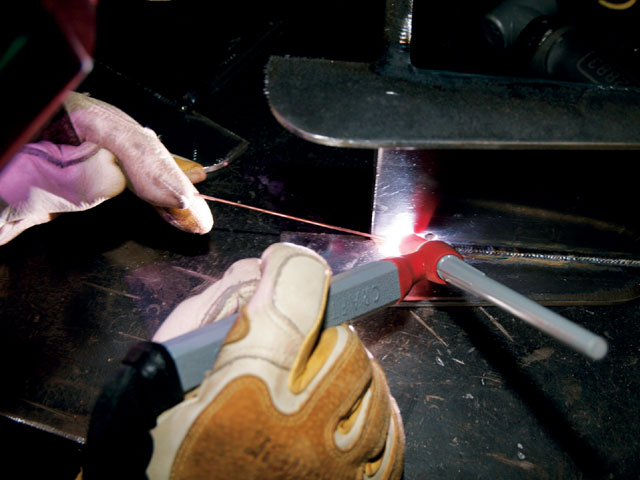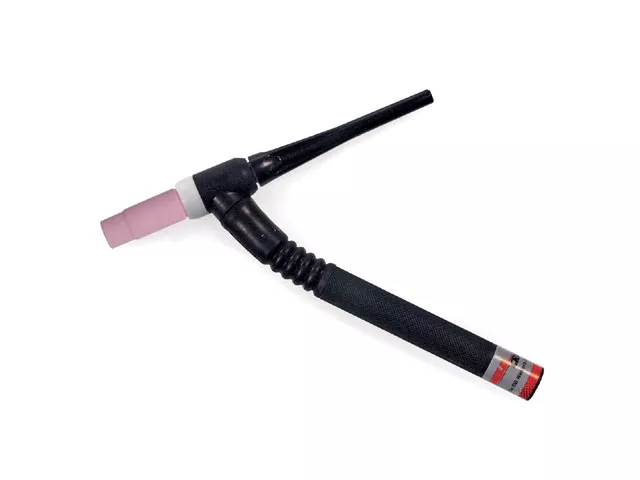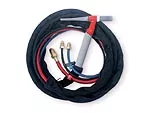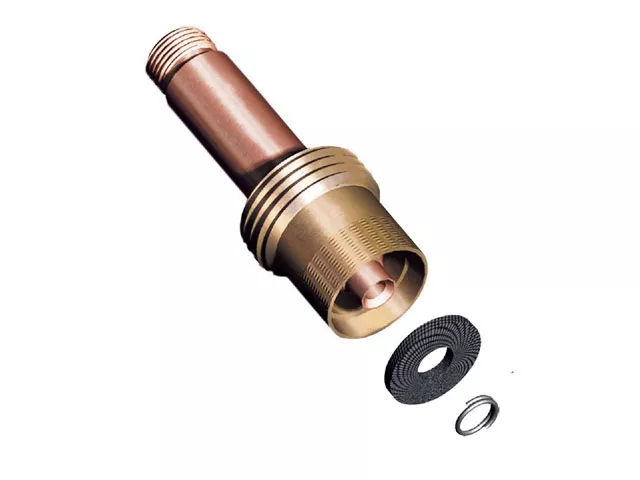Considering TIG Welding?


2. A TIG torch with a flexible neck (as shown here) helps improve access to difficult joints.

3. Check water-cooled torches periodically for leaks that can lead to overheating and torch damage.

4. A gas lens with a durable porous media provides good shielding gas coverage and last longer than multiple screen versions.
TIG welding (also called GTAW or gas tungsten arc welding) is considered by some to be the toughest process to learn. Whether or not that is true, one thing is certain: you can weld more base metals with TIG than anything else, which makes it ideal for bike fabrication and repairs.
TIG welding is a very clean welding process, which is one reason many people like it. It does not produce sparks, spatter, or fumes (although proper ventilation is always recommended), and it requires little clean up. It is also ideal for welding on thinner materials, especially those less than 1/4-inch.
During TIG welding, a tungsten electrode creates an arc and transfers the current to the material being welded. To protect the weld puddle from contaminants, the process requires the use of a shielding gas, typically argon. You usually need to use a filler metal during TIG welding, which you feed into the weld pool by the opposite hand than that holding the TIG torch. TIG filler metals are often called rods or cut-lengths and are available in diameters ranging from 1/16- to 1/4-inch.
Having the right equipment for TIG welding and properly maintaining it is important. Take the torch. Since it is responsible for carrying and directing the welding current to the weld joint, it can have a big impact on your welding success.
The Torch: From the Machine Forward
There are two options when selecting hoses or cables for a TIG torch: vinyl or rubber. These are available for both air- or water-cooled torches.
For either type of TIG torch, rubber hoses and cables, especially braided ones, are recommended for their longevity and welding performance. They offer good heat resistance, up to 300 degrees Fahrenheit (compared to 150 to 200 degrees Fahrenheit for vinyl), and also resist kinking, which prevents disruption to the shielding gas flow that can lead to problems like porosity. Rubber hoses and cables also maintain their flexibility and durability in cold environments better than vinyl and offer good protection against high frequency leakage.
Next, choose a TIG torch with the right handle for the job, specifically one that is comfortable to hold and one that offers the appropriate cooling capacity needed for the application. Generally, there are two available types of handles: smooth (sometimes called knurled) or ribbed.
Ribbed handles help improve cooling capacity on air-cooled torches, and are often shipped standard from the factory when you order this type of TIG torch. Conversely, smooth handles offer good thermal conductivity for water-cooled torches. These two types of handles can be interchanged; however, it is important to be sure that both are made of durable electrical grade plastic. This compound helps resist cracking and protects against high frequency shocks.
If the power source being used does not have a gas solenoid, choose a torch body that includes a gas valve control. This valve can be turned on and off as needed to minimize unnecessary shielding gas usage.
The TIG torch body should feature good insulation, as this protects against damage from day-to-day use, helps extend torch life, and shields against high frequency leakage. Most TIG torch manufacturers surround the torch body with silicon rubber insulation, and some specifically use a high-dielectric type. High-dielectric silicon rubber withstands higher voltages without breaking down, which helps lengthen the life of the torch. Silicon rubber insulated torch bodies are also more resilient than hard phenolic torch bodies (another torch body option) to resist cracking if dropped.
To ensure good arc stability, and with it good welding performance, a TIG torch body should feature heavy copper construction, along with highly conductive copper components, such as collets and collet bodies. In particular, collets and collet bodies composed of a tellurium-copper alloy offer the best conductivity; they are also more resistant to heat than standard copper ones and they resist twisting or elongating to hold the tungsten more securely. A secure tungsten equals a steady arc and good weld quality.
Backcaps are composed of an assortment of phenolic compounds, which have varying degrees of heat resistance. Select a backcap that is composed of compounds that fit the amperage requirements of the application. For example, if the TIG torch is used for general-duty applications, a backcap made of a low-temperature phenolic compound will suffice. A backcap with a higher thermal resistance should be selected for more demanding applications.
If greater shielding gas coverage is required for the TIG application, or joint access is limited, you should add a gas lens to the TIG torch. Select a gas lens comprised of a durable porous media (as opposed to multiple thin screens).
Selecting the right nozzle for the application is also an important factor when choosing a TIG torch. Lava nozzles offer good crack resistance for medium-amperage applications. Alumina oxide nozzles are appropriate for low amperage applications.
Beyond The Components: A Few Final Considerations
Components aside, you’ll also need to determine whether an air- or water-cooled TIG torch is best suited for the application. As a rule, an air-cooled torch is a good option for lower amperage applications (under 200 amps) and a water-cooled torch would be used for applications requiring more than 200 amps.
Air-cooled torches are heavier, as they rely on the surrounding air to cool them, so make sure to select one with a comfortable handle. Consider where the welding will take place, too. Outdoor applications lend themselves to the more portable air-cooled TIG torch, whereas shop applications can better accommodate a water-cooled torch and its accompanying water cooler.
Also, there are flexible necks available for most TIG torches. They should be considered when you have particularly tight joints to weld, or for welding in awkward positions.
Some torch body styles feature a modular design, which allows not only a flexible neck to be added, but also different head angles. These types of modular TIG torches work well for complex joints and/or for applications with a variety of different angles that need to be reached.
Remember, a TIG torch, no matter the application, plays an important part in the overall TIG welding process. Take care to select one that meets your needs and that complements your power source. It will save time, money, and a lot of headaches.
Ten Easy Tips For Maintaining Your Tig Torch
Once you’ve chosen the most appropriate TIG torch and components for your application, routine inspections and some simple maintenance can help make them last.
1. Use a woven nylon cable cover with a plastic zipper to protect hoses and cables from cuts caused by dragging.
2. Periodically remove the collet and collet body and wire brush them to remove oxides that can lead to an erratic arc and shorten consumable life.
3. Make sure all threads on connecting points of the torch are tightened properly to prevent problems with electrical conductivity that can damage the torch’s front-end parts.
4. Visually inspect the nozzle to look for cracking or blackening. Replace the nozzle if any such damage is evident.
5. Check for cracks in the handle to avoid injury from shocks. Do not tape the handle, as this will only prolong the problem. If the handle is cracked, it should be replaced.
6. Visually inspect the silicon rubber insulation surrounding the torch body for any cuts. Check a phenolic torch body for cracks. Replace either torch body if any deep gouges or cuts are found.
7. Look for cracks or signs of deterioration on the insert, or O-ring, attached to the threaded portion of the backcap. If needed, replace to prevent aspiration (pulling of air into the torch body), as this can lead to weld discontinuities.
8. Keep the threads connecting the backcap and torch body clean, look for any signs of wear on the threads, and replace as necessary.
9. Test that the power connector is snugly tightened to the power source to prevent overheating and damage to the torch cable. Also be certain all gas and water fittings are secure to prevent leaks.
10. When using a water-cooled torch, periodically remove the handle to check water connections for leaks that can lead to torch overheating and damage.







